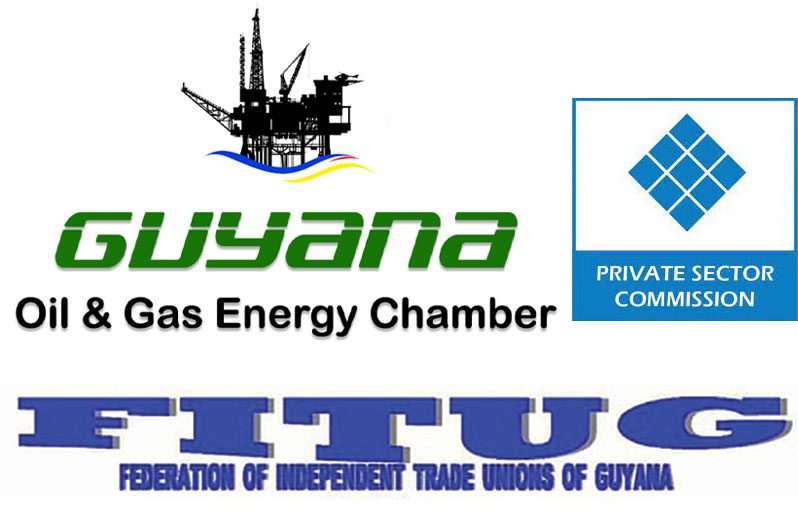–private sector, civil society stakeholders say
GUYANA’S ability to secure revenue from the sale of carbon credits accrued from the preservation of forest resources is owed to the country’s visionary leadership, private sector and civil society stakeholders have said.
The Private Sector Commission (PSC), in a statement on Saturday, commended the Government of Guyana on its visionary leadership, which has resulted in Guyana becoming the first country to be issued carbon credits for successfully preventing forest loss and degradation under the REDD+ initiative.
“The Commission strongly believes that the deal signed on December 2, 2022 between the government and Hess Corporation for Guyana to be paid a minimum of US$750 million between 2016 and 2030 is a demonstration of Guyana’s commitment towards global climate action,” the PSC said.
Importantly, according to the Commission, the deal shows what corporations like Hess, a partner in the Stabroek Block offshore Guyana, can do to demonstrate leadership and action in the fight against climate change.
The PSC envisions that the funds to be provided from this historic agreement will help realise the objectives outlined in the Low-Carbon Development Strategy 2030 (LCDS 2030).
President of the Guyana Oil and Gas Energy Chamber (GOGEC), Manniram Prashad is also optimistic about this initiative.
He said: “Despite Guyana is projected to ramp up oil production to approximately one million barrels per day by the end of the decade, Guyana will still enjoy a net negative position in terms of carbon emission.
“The Low-Carbon Development Strategy (LCDS 2030) sets out the vision for a low- carbon economy through low-carbon energy, employment and development opportunities, and investment in adapting to the impacts of climate change.”
The average annual weather-related disaster losses in the last five to ten years in “low” and “lower-middle” income countries have reached US$1.3 billion and US$6.8 billion, respectively.
Climate impacts undermine resilience and the capacity to recover and absorb losses from these events, especially that of poorer countries and their citizens, by reducing their agricultural productivity, weakening water and food security, increasing the incidence of diseases, and threatening the existing infrastructure, economic productivity, and value chains.
“More focus needs to be placed on the more vulnerable groups who are the victims suffering the most from the wrath of such catastrophes. This should not only be limited to sustainable development work to lift people out of poverty by economic empowerment through education, but countries also must divert investment into building climate resilient infrastructure,” Prashad said.
The Chamber said to move towards climate resilience, countries would need to design disaster risk reduction and climate change adaptation strategies. The objective in so doing is to build climate-resilient economies while simultaneously developing creative financing solutions over the long-term to be able to adequately respond to the financial and economic damages whenever such risks occur in member states.
In commending the government, the GOGEC said Guyana’s expanded LCDS framework and this innovative carbon-credit model is demonstrative of its stewardship in successfully leading in these respects.
The Federation of Independent Trade Unions of Guyana (FITUG) also extended congratulations to the Government of Guyana, particularly President Dr. Irfaan Ali and Vice-President Dr. Bharrat Jagdeo on the sale of carbon credits.
ENVIRONMENTAL PROTECTION
The Federation acknowledged that Guyana is once again in the forefront of environmental protection and mitigation of the existential challenges posed by climate change.
“As a patriotic organisation, we see the agreement inked with the Hess Corporation as yet another milestone in our long-standing efforts to preserve our forests to the benefit of the world’s people. The unlocking of further resources for national development, with a substantial sum directed to our First Peoples is yet another reason for the Federation to be optimistic for the future.
“The FITUG, having participated in the deliberations on the Low-Carbon Development Strategy (LCDS) in its present and past incarnations, is of the firm belief that the strategy offers our people a roadmap for the future, which balances our development ambitions and our environment,” the Federation said.
The group, however, lamented: “We believe that had valuable time not been lost between 2015 and 2020 [under the APNU+AFC], our efforts may have been further along. Inasmuch as we are disappointed by the lack of emphasis during that period, we believe that every effort will be made to make up some of the time lost. We also anticipate that in the coming times, further sale will accrue greater resources for a service our country provides to the entire planet.”
In a statement, the Association for Democracy and Human Rights (ADHR) said, too, that with the specific actions contained in the Low-Carbon Development Strategy 2030, Guyana stands at the summit of advancing the global cause to reduce carbon emissions.
“This move is in view of the scientifically proven fact that in order to avert the worst impacts of climate change, and preserve a livable planet, the carbon emissions in the atmosphere need to be absorbed by the oceans and forests,” the Association said.
As such, the ADHR believes that the signing between Hess and Guyana reinforces Guyana’s position as a leader in advancing global efforts for a “green” future, with the country having more than 18 million hectares of forests storing an estimated 20 billion gigatonnes of carbon dioxide equivalent, the Government of Guyana’s low-carbon trajectory lends to an economically-bright and environmentally sound future for the country.
“Even more commendable is the announcement of the instantaneous apportioning of over US$112M, or the benchmark 15 per cent of all Carbon Credit sale to go to Amerindian communities,” the Association said.




.jpg)









